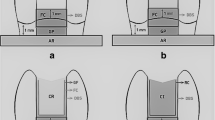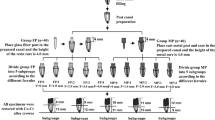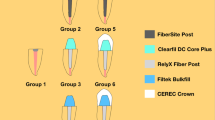Abstract
The aim of this study is to investigate the effect of different restoration methods applied to model teeth with a C-shaped root canal configuration on fracture strength. A total of 76 artificial tooth models were made using images of a molar tooth with a C-shaped root canal anatomy. The teeth were randomly divided into seven groups and different restorations, such as resin composite (2), bundled fiber post and resin composite (3), vertical fiber post and resin composite (4), horizontal fiber post and resin composite (5), woven fiber post and resin composite (6) and composite endocrown (7) were applied to the different groups except control group (1). The artificial teeth were embedded in acrylic blocks and subjected to fracture tests. The data were analyzed using one-way analysis of variance, Monte Carlo Pearson Chi-square, Pearson Chi-square, and Fisher’s exact test (P < 0.05). All groups differed in terms of fracture strength (P = 0.001). The highest fracture strength observed in group 6, and there was a significant difference between group 6 and group 4 based on a least significant difference pairwise comparison test. In terms of fracture type, the highest reparability percentage (100%) observed in group 7. The fracture strength values of endocrown restorations and woven fiber-reinforced resin composite restorations were found to be as high as those of the intact models. Considering also fracture restorability, endocrown restorations may be recommended for teeth with C-shaped root canal anatomy. The usage of the 3D tooth models in the studies offer a valuable opportunity in terms of the standardization of the samples, particularly in teeth with anatomical variations. This study shows that using of this technology, homogeneous groups can be created and experimental studies can be improved.



Similar content being viewed by others
References
Jafarzadeh H, Wu YN. The C-shaped root canal configuration: a review. J Endod. 2007;33:517–23.
Kato A, Ziegler A, Higuchi N, Nakata K, Nakamura H, Ohno N. Aetiology, incidence and morphology of the C-shaped root canal system and its impact on clinical endodontics. Int Endod J. 2014;47:1012–33.
Fan B, Cheung GSP, Fan M, Gutmann JL, Bian Z. C-shaped Canal System in Mandibular Second Molars: part I; Anatomical Features. J Endod. 2004;30:899–903.
Karzoun W, Abdulkarim A, Samran A, Kern M. Fracture strength of endodontically treated maxillary premolars supported by a horizontal glass fiber post: an in vitro study. J Endod. 2015;41:907–12.
Kemaloğlu H, Kaval M, Türkün M, Micooğulları K. Effect of novel restoration techniques on the fracture resistance of teeth treated endodontically: an in vitro study. Dent Mater J. 2015;34:618–22.
Eapen AM, Amirtharaj LV, Sanjeev K, Mahalaxmi S. Fracture Resistance of Endodontically Treated Teeth Restored with 2 Different Fiber-reinforced Composite and 2 Conventional Composite Resin Core Buildup Materials: an in vitro study. J Endod. 2017;43:1499–504.
Bromberg CR, Alves CB, Stona D. Fracture resistance of endodontically treated molars restored with horizontal fiberglass posts or indirect techniques. J Am Dent Assoc. 2016;147:952–8.
Baranwal H, Baranwal AK, Srivastava A. Management of fractured maxillary incisor with biodentine, everstick glass fiber as post and composite resin. Endodontology. 2015;27:57.
Jerome CE. C-shaped root canal systems: diagnosis, treatment, and restoration. Gen Dent. 1994;42:424–7.
Ordinola-Zapata R, Bramante CM, Duarte MA, Cavenago BC, Jaramillo D, Versiani MA. Sha** ability of reciproc and TF adaptive systems in severely curved canals of rapid microCT-based prototy** molar replicas. J Appl Oral Sci. 2014;22:509–15.
Torabi K, Farjood E, Hamedani S. Rapid prototy** technologies and their applications in prosthodontics. J Dent Shiraz Univ Med Sci. 2015;16:1–9.
Webb PA. A review of rapid prototy** (RP) techniques in the medical and biomedical sector. J Med Eng Technol. 2000;24:149–53.
Gök T, Çapar ID, Akçay I, Keleş A. Evaluation of Different Techniques for Filling Simulated C-shaped Canals of 3-dimensional Printed Resin Teeth. J Endod. 2017;43:1559–64.
Bijelic J, Garoushi S, Vallittu PK, Lassila LV. Fracture load of tooth restored with fiber post and experimental short fiber composite. Open Dent J. 2011;5:58–65.
Fonseca RB, Fernandes-Neto AJ, Correr-Sobrinho L, Soares CJ. The influence of cavity preparation design on fracture strength and mode of fracture of laboratory-processed composite resin restorations. J Prosthet Dent. 2007;98:277–84.
Hayes A, Duvall N, Wajdowicz M, Roberts H. Effect of Endocrown Pulp Chamber Extension Depth on Molar Fracture Resistance. Oper Dent. 2017;42:327–34.
Yin X, Cheung GS, Zhang C, Masuda YM, Kimura Y, Matsumoto K. Micro-computed tomographic comparison of nickel-titanium rotary versus traditional instruments in C-shaped root canal system. J Endod. 2010;36:708–12.
Fokkinga WA, Kreulen CM, Vallittu PK, Creugers NH. A structured analysis of in vitro failure loads and failure modes of fiber, metal, and ceramic post-and-core systems. Int J Prosthodont. 2004;17:476–82.
Heydecke G, Butz F, Strub JR. Fracture strength and survival rate of endodontically treated maxillary incisors with approximal cavities after restoration with different post and core systems: an in-vitro study. J Dent. 2001;29:427–33.
Lertchirakarn V, Palamara JE, Messer HH. Patterns of vertical root fracture: factors affecting stress distribution in the root canal. J Endod. 2003;29:523–8.
Gresnigt MM, Ozcan M, van den Houten ML, Schipper L, Cune MS. Fracture strength, failure type and Weibull characteristics of lithium disilicate and multiphase resin composite endocrowns under axial and lateral forces. Dent Mater. 2016;32:607–14.
Hamdy A. Effect of full coverage, endocrowns, onlays, inlays restorations on fracture resistance of endodontically treated molars. J Dent Oral Hyg. 2015;5:2.
Plotino G, Grande NM, Isufi A. Fracture Strength of Endodontically Treated Teeth with Different Access Cavity Designs. J Endod. 2017;43:995–1000.
Schwartz RS, Robbins JW. Post placement and restoration of endodontically treated teeth: a literature review. J Endod. 2004;30:289–301.
Dietschi D, Duc O, Krejci I, Sadan A. Biomechanical considerations for the restoration of endodontically treated teeth: a systematic review of the literature, Part II (Evaluation of fatigue behavior, interfaces, and in vivo studies). Quintessence Int. 2008;39:117–29.
Latempa AM, Almeida SA, Nunes NF, da Silva EM, Guimarães JG, Poskus LT. Techniques for restoring enlarged canals: an evaluation of fracture resistance and bond strength. Int Endod J. 2015;48:28–36.
Caputo AA, Standlee JP. Pins and posts-why, when and how. Dent Clin North Am. 1976;20:299–311.
Chai WL, Thong YL. Cross-sectional morphology and minimum canal wall widths in C-shaped roots of mandibular molars. J Endod. 2004;30:509–12.
Cheung LH, Cheung GS. Evaluation of a rotary instrumentation method for C-shaped canals with micro-computed tomography. J Endod. 2008;34:1233–8.
Amal N, Mali G, Sreeja A, Jamuna S, Babu A, Anulekh, . Endocrown-an overlooked alternative. Arch of Dent and Med Res. 2016;2:34–44.
Acknowledgements
We thank to Prof. Dr. Saim Yologlu (a full time faculty member at Inonu University, Faculty of Medicine, Department of Biostatistics) who made the statistics of this study.
Funding
This project was supported by Inonu University/Turkey, Scientific Research Projects Unit (TDH-2018–887).
Author information
Authors and Affiliations
Contributions
All authors have contributed significantly and, all authors are in agreement with the manuscript.
Corresponding author
Ethics declarations
Conflict of interest
The authors declare that they have no conflict of interest.
Ethical approval
This study was approved by the Inonu University Health Sciences Non-Interventional Clinical Research Ethics Committee (2017/24-16).
Informed consent
For this type of study, formal consent is not required.
Additional information
Publisher's Note
Springer Nature remains neutral with regard to jurisdictional claims in published maps and institutional affiliations.
Rights and permissions
About this article
Cite this article
Cetin, M.S., Simsek, N. Evaluation of fracture strength of different restoration techniques applied to C-shaped 3D model teeth. Odontology 110, 262–268 (2022). https://doi.org/10.1007/s10266-021-00655-8
Received:
Accepted:
Published:
Issue Date:
DOI: https://doi.org/10.1007/s10266-021-00655-8




